#Vlisco
Explore tagged Tumblr posts
Text
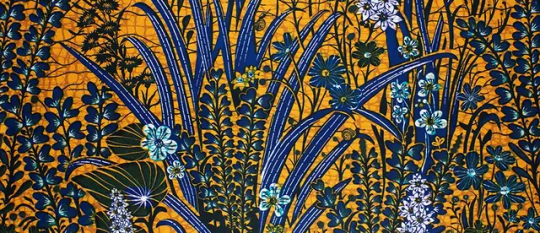
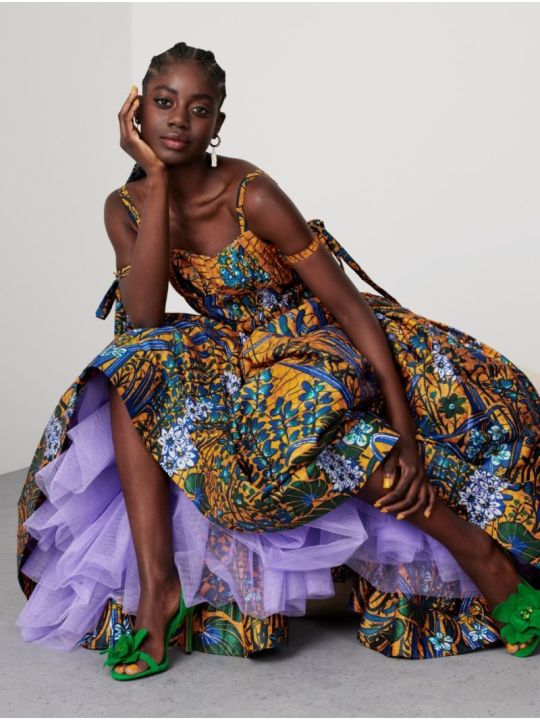
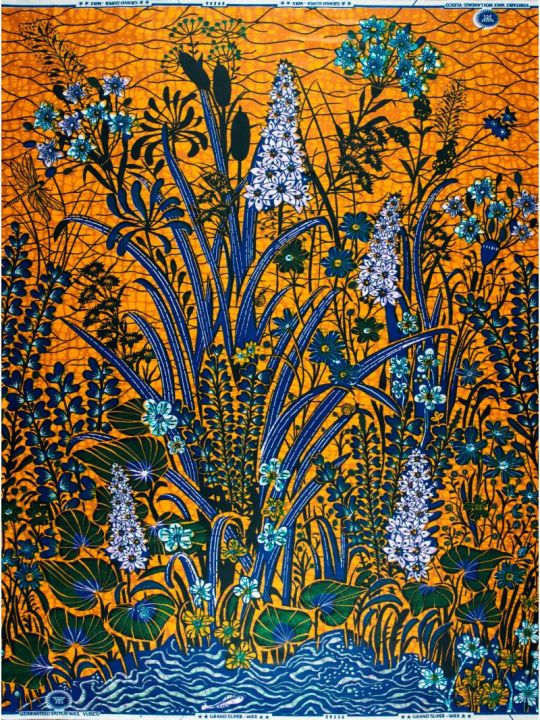
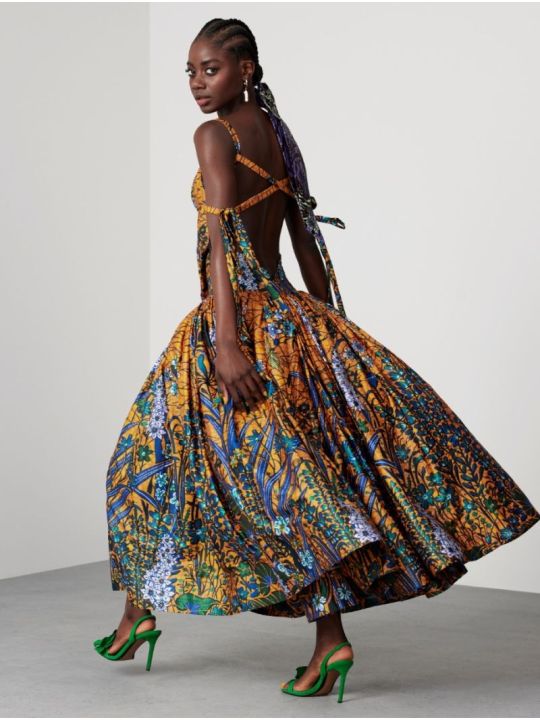

Floral-patterned Grand Super-Wax fabric by Vlisco
'A more exclusive version of Super-Wax, rich in colours and bubbling, and printed with a gloss finish. The most defining (and beloved) feature of a Super-Wax is its duo-colour “bubbling” print effect...
...Grand Super-Wax is a luxurious twist on the original, using Vlisco cotton satin. Grand Super-Wax is made using a highly-unique wax printing technique unlike any other in the world: every piece is created with an unequalled and extraordinary level of care and precision.
First, a design in liquid wax is printed on cotton satin. A base dye such as indigo soaks into the cloth around the wax, leaving behind a deep, intense colour. The magic of the ‘wax-breaking’ during the printing process results in a large, irregular pattern of vein-like bubbles throughout the design.
One single piece of Grand Super-Wax goes through an average of 27 total step before it receives a final gloss finish, and a select number of Grand Super-Wax fabrics are covered from edge-to-edge in transparent glitter.'
#dutch wax#african wax#fashion#dress fabric#pattern#print#vlisco#batik#wax resist#wax print#surface pattern#surface pattern design#pattern design#textile design#textiles#printed textiles#2024#floral#flowers
168 notes
·
View notes
Text




VLISCO | Blooming Beauty Photographed by Togo Yeye
27 notes
·
View notes
Text

Yinka Shonibare in Lisse Art Museum (LAM)
Historically inspired costumes with Vlisco-style fabrics.
25 notes
·
View notes
Text


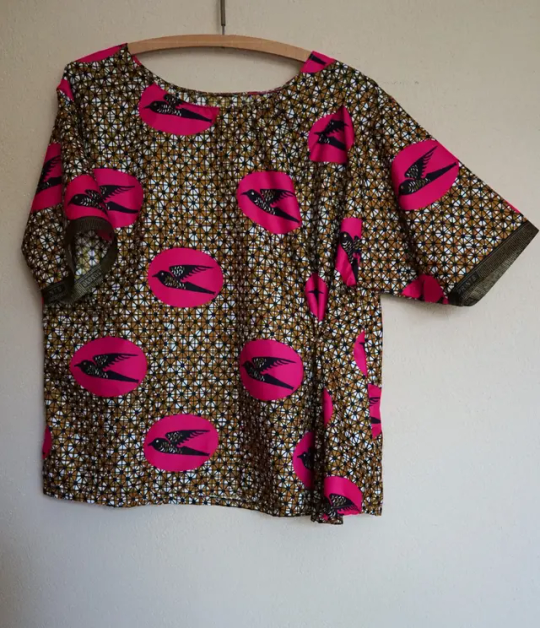
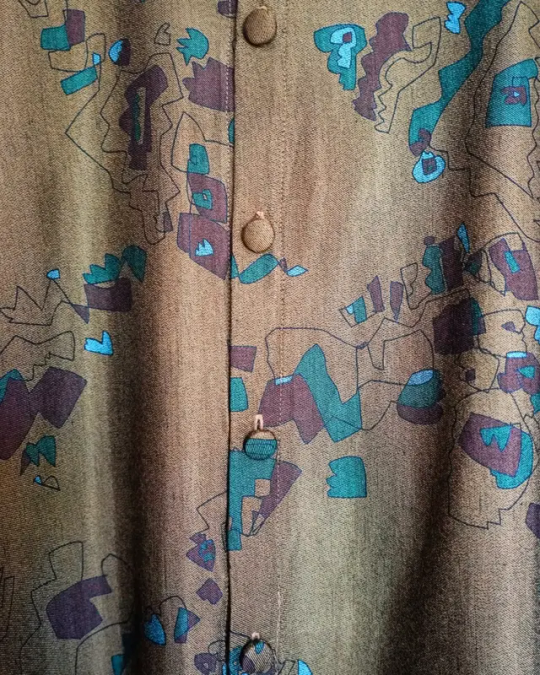
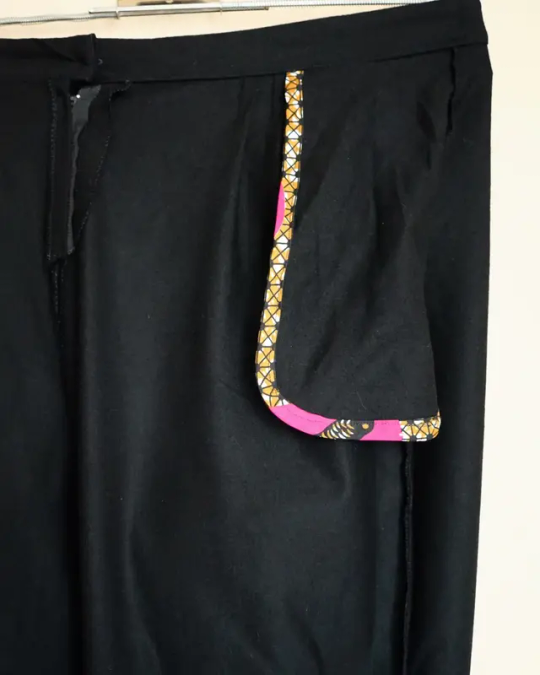
I made these black woollen trousers to go with these two tops I made earlier. The trouser pockets are the same Vlisco fabric as the asymmetric top. The fabric of the blouse might be real silk(?), but I got it secondhand for 3 euros! It reminds me of a map, and I love the green on gold.
Trouser pattern is from Knipmode, october 2019, asymmetric top from Jen Hewett's Print, Pattern, Sew (but I added the pleat), and the blouse pattern is Bruna from La Maison Victor with just the collar stand instead of the regular collar.
3 notes
·
View notes
Text
Ankara Fabric: How to buy it and the different types
HARARE – Ankara fabric got its name from a mispronunciation of the Capital or Ghana ACCRA which was central in popularizing this Dutch wax fabric. The fabric was trying to enter Indonesian markets and created a cheaper one, which was rejected by Indonesians but made its way into West African upper class and middle class culture. Beyoncé Knowles Carter in an Ankara designer suit Continue reading…
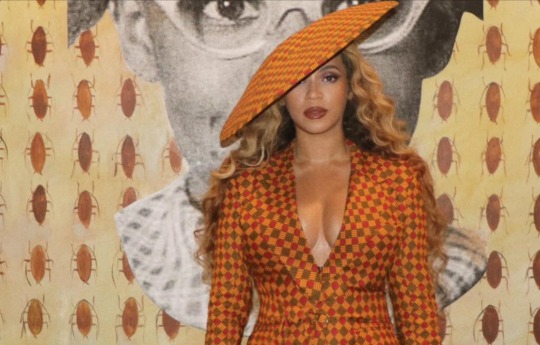
View On WordPress
#african#african american#African Fashion#African Print#Ankara Fabric#anningtex#beauty#beyonce#black fashion#black hair#fashion#Featured#Ghana#hair#Harare#style#Travel#VLISCO#woodin#zimbabwe#Zimbabwe Fashion
2 notes
·
View notes
Text
Vlisco fabric I bought to make a quilt. Six yards of misprinted horses.
0 notes
Text
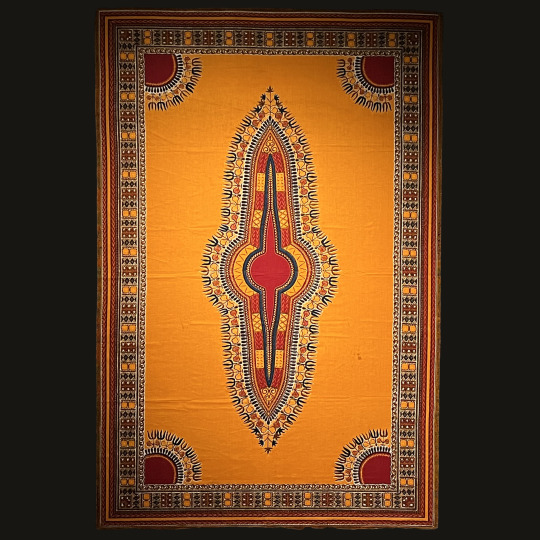
NoTextingAndWalking
NewYorkCity
Manhattan
MuseumAtFIT
@museumatFIT
AfricasFashionDiaspora
AngelinaVliscoPrint
Vlisco
Netherlands
WaxPrint
Dashikis
BriceDailyPhoto
#NoTextingAndWalking#NewYorkCity#Manhattan#MuseumAtFIT#@museumatFIT#AfricasFashionDiaspora#AngelinaVliscoPrint#Vlisco#Netherlands#WaxPrint#Dashikis#BriceDailyPhoto
0 notes
Text

The Vlisco Group designs, produces and distributes fashion fabrics, especially of the African wax print style, for the West and Central African market and African consumers in global metropolitan cities. Founded in Helmond, the Netherlands, in 1846, the Vlisco Group and their fabrics have grown into an essential part of African culture, receiving widespread attention from the art, design and fashion worlds. Vlisco Group's brand portfolio consists of four brands: Vlisco, Woodin, Uniwax and GTP. The company's head office, as well as the design and production facilities for the Vlisco brand, are located in Helmond. For the other brands these facilities are based in Ghana and Ivory Coast. The Vlisco Group has eight sales offices in numerous African countries and around 2,700 employees (900 in The Netherlands and 1,800 in Africa).
History

Vlisco textile with crystals
Vlisco Group was founded in 1846, when Pieter Fentener van Vlissingen bought an existing textile printing factory and named it P. Fentener van Vlissingen & co., aiming to produce and sell hand printed fabrics in- and outside of the Netherlands.[1]: 27 Originally, production included handkerchiefs, bedspreads, chintz and furniture fabrics. In the second half of the 19th century, Fentener van Vlissingen started exporting imitation batiks to what was then called the Dutch East Indies after he was told by his uncle that there was a pressing need for affordable fabrics. Thanks to the invention of roller printing, it was possible to recreate the batik look a lot less labour-intensively, which meant that Fentener van Vlissingen could produce it quicker and sell it cheaper than local craftsmen could. This was also its only selling point, as the Indonesians did not care for the too even look of the imitation batiks.[1]: 28–30
That Fentener van Vlissingen's fabrics came to West Africa is rather logical. Once the Dutch East Indies banned imitation batiks, Fentener van Vlissingen had to search for a new market to sell his goods. Since the start, the company has produced and sold hand-printed textiles both domestically and abroad. Around 1852, the VOC Dutch East Indies trade routes became involved in the export of the hand-printed Vlisco fabrics. The fabrics were used for bartering during stopovers in Western Africa. Since the Dutch had been dealing in European luxury goods with West-Africans since the Late Middle Ages, it seemed a logical step to move selling activities to that region. Another reason is that the fabrics sold in Indonesia had become popular among the Belanda Hitam, Ghanaian soldiers who served in the Royal Netherlands East Indies Army and returned home between 1837 and 1872.[1]: 30
By the time the 20th century rolled around, West- and Central Africa were growing into a booming textile market and by the 1930s the 'wax hollandais' cloth's designs were being adapted to local tastes.[2]
In 1927 the company changed its name to Vlisco, a contraction of Vlissingen & co., but the fabrics were by then widely known as 'Dutch Wax' or 'Wax Hollandais', and those names stuck. During World War II, production was stopped and the finished fabrics could not be shipped to the African markets. The African fabric markets were starved of Dutch Wax for the entirety of the war and when in 1945 Vlisco managed to send a shipment of a fabric called 'Six Bougies' , it was an immediate success.[1]: 30 So much so, that from 1963 onwards, all Vlisco fabrics have the text 'Guaranteed Dutch Wax Vlisco' stamped on the side, because the fabrics were and still are widely counterfeited.
Unlike the Vlisco brand, the entire process – from design to production and distribution – for the Woodin, Uniwax and GTP brands takes place in Africa. When, in the mid-1960s, the import duties on printed textiles were doubled in several Western African countries, a percentage of imports were replaced by local production. This led to the establishment of the GTP (Ghana Textiles Printing Company) brand in 1966, with production taking place at a factory in Ghana, and the establishment of Uniwax in 1970, with production facilities in the Ivory Coast (Koert van, Robin, Dutch Wax Design Technology: van Helmond naar West-Afrika, 2008). The pan-African brand Woodin has been produced in both the GTP and Uniwax factories since 1985. Furthermore, Vlisco made a historical decision in 1993 by abandoning hand printing, to be able to produce fabric on a larger scale.[3]
Over time, The Vlisco brand has developed a highly sophisticated production process, whereby the fabric goes through 27 treatments, both by machine and by hand, and takes two weeks to produce. This process is a closely guarded secret. Since 2006, the company has been aiming at high end markets and is currently preparing to release a ready to wear fashion line.[4]
The Vlisco Group carries four brands: Vlisco, Woodin, Uniwax and GTP. Each of these brands has its own style, brand identity and consumer target group. Four times a year, the Group launches a new collection of fashion fabrics under their premium luxury flagship brand Vlisco, designed and produced in Helmond. Since it was established in 1846, Vlisco designs and fabrics, have grown to become an essential part of African style culture, with deep-rooted influences across all layers of society. Uniwax and GTP are designed and produced in Ivory Coast and Ghana and focus on the growing middle class in West and Central Africa. Woodin is the smallest, but fastest-growing brand in Vlisco Group's brand portfolio. At this moment, 60% of the population in West- and Central Africa is under 25 years old. This segment is growing, extremely connected via social media and mobile devices and show fast changes in consumer behavior regarding to lifestyle, fashion and media usage. The lifestyle brand Woodin focusses on this consumer group.
Postcolonial criticism
Critics, such as Tunde Akinwumi, feel that Vlisco's origins are misleading, especially since the company profiles itself as the 'originator of African Wax'. Akinwumi's 2008 article, 'The "African Print" Hoax', argues that producers of African prints mislead customers by pretending to sell authentic African designs, while they are in fact based on Chinese, Indian, Japanese, Arabic and European imagery. Therefore, he advocates a new African aesthetic, based on traditional African fabrics, such as kente, adire, aso oke and bogolanfini, and expresses hope that textile producers and governments will support this cause and help change Africa's image to a more authentic one.
In his book Vlisco, Jos Arts, however, represents the counter critics, who are of the opinion that critics like Akinwumi have misunderstood a main principle of fashion, namely that it is subject to constant change and therefore even though Vlisco's fabrics were initially not authentically African, the century-long process of appropriation and mutual influence ensures that it has become so.[5]: 92
In the realms of art, Vlisco fabrics are extensively used by British-Nigerian artist Yinka Shonibare, who dresses headless mannequins in baroque gowns and suits, to challenge Western colonial history.[5]: 10
Symbolism
Vlisco fabrics are given an interesting form of symbolism, which allows African women to speak out, yet stay silent. Once a fabric has been designed and shipped, it is given a name which often ties into local sayings by the saleswomen. An example of this is a fabric with a print of open bird-cages and two birds flying out, that goes by the title "Si tu sors, je sors" (You leave, I leave), which means to say "If you think this marriage is something you can take and leave as you please, I will do the same." Other fabrics are known as 'Come to my bedroom wearing your slippers' or 'Kofi Annan's brain". What is important to consider in all this is that this kind of symbolism is only possible both because the messages are open to multiple interpretations and the fabrics are worn as dresses, and no one can divorce or attack a woman for wearing a pretty dress.
1 note
·
View note
Photo
Gorgeous
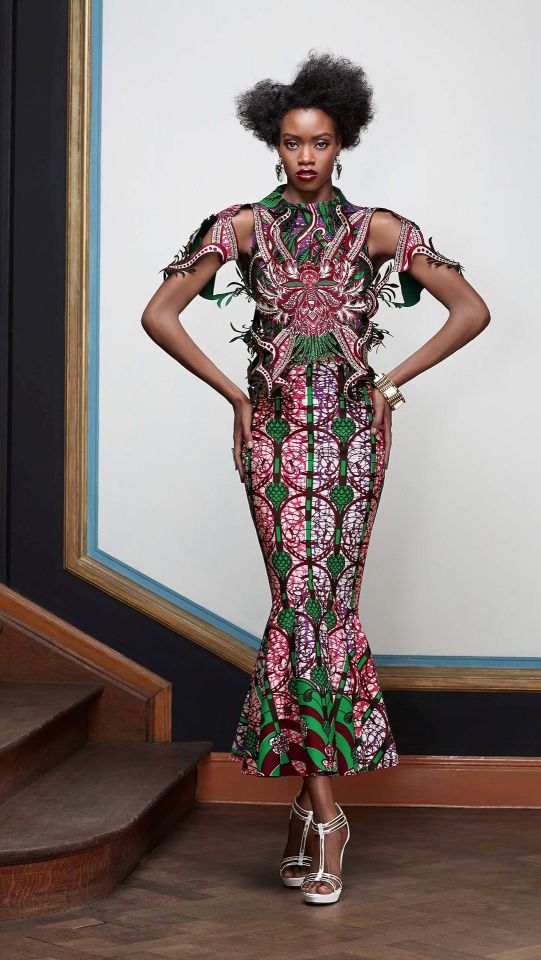


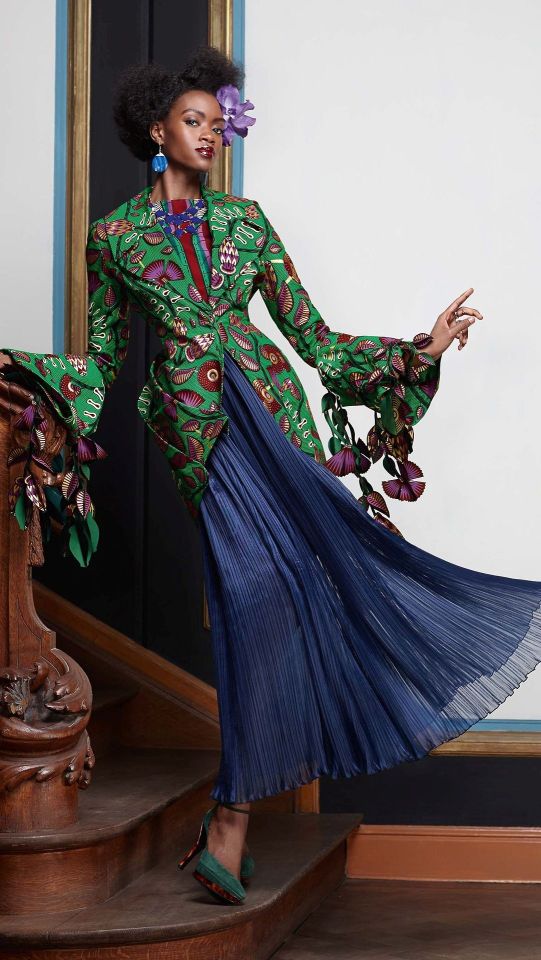
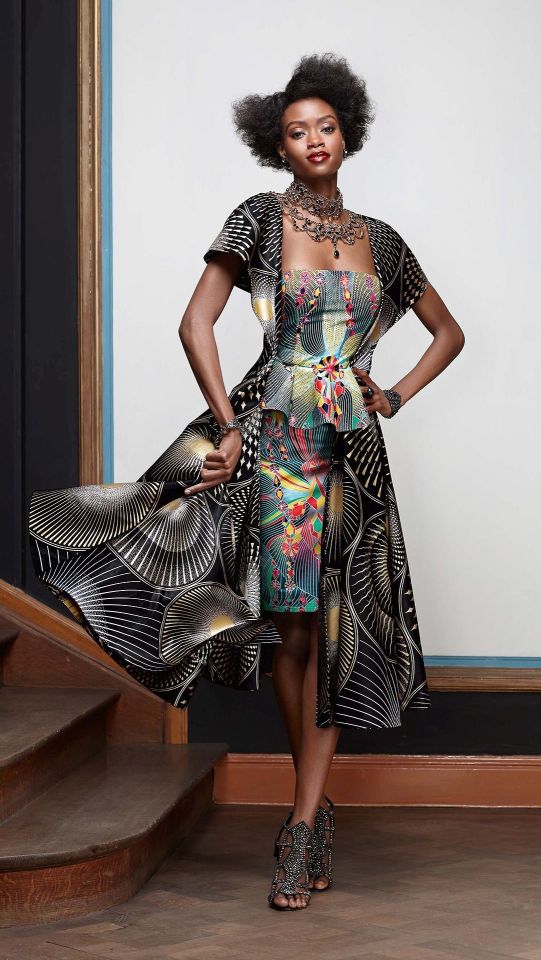
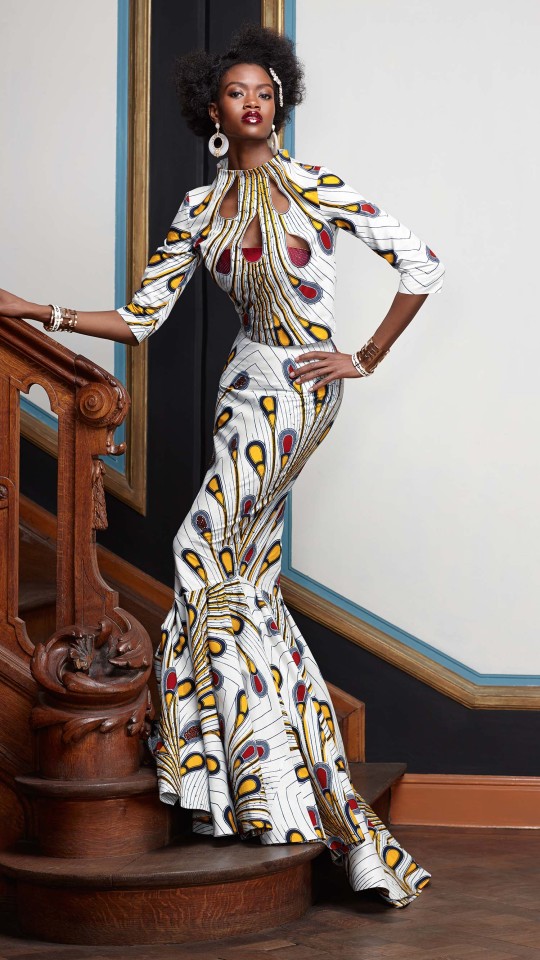



Vlisco fabrics
3K notes
·
View notes
Text
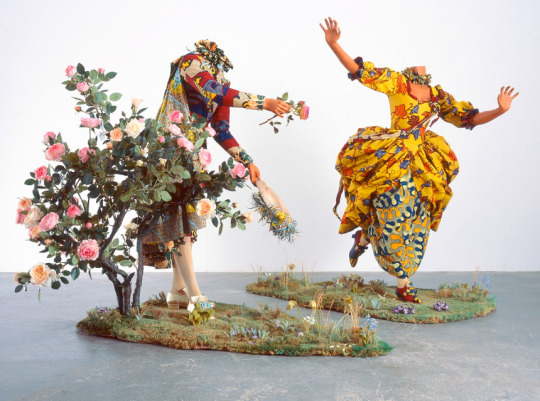
Was passsiert !
1 note
·
View note
Text
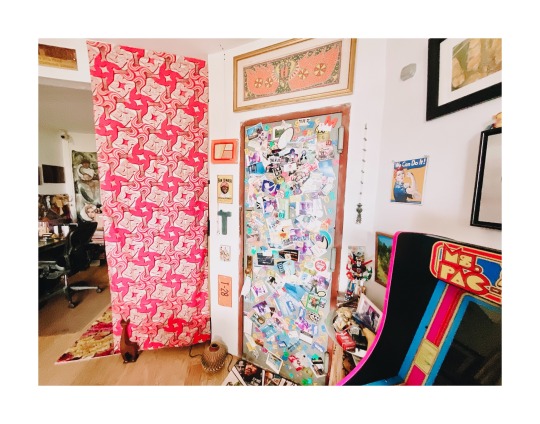
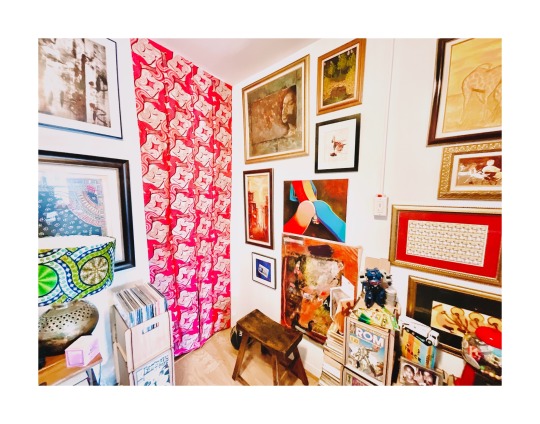
Ronavations continued
After all the time I spend in my home especially over the last fifteen to twenty years, the fact that I finally did the thing that it seems whyte folks talk about all the time, renovations. I previously spoke about my favorite spot in my home, but now I want to talk about a decorative feature that I came up with to top-off all of the improvements of my intimate space.
One thing that I think is important when you have an open floor plan or a space with no clear distinguishable rooms, you need to create areas and nooks within that space, forced delineations that guide your eye and your body to where to go or not to go.
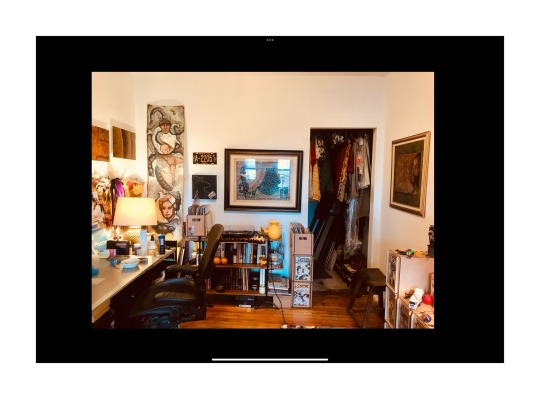
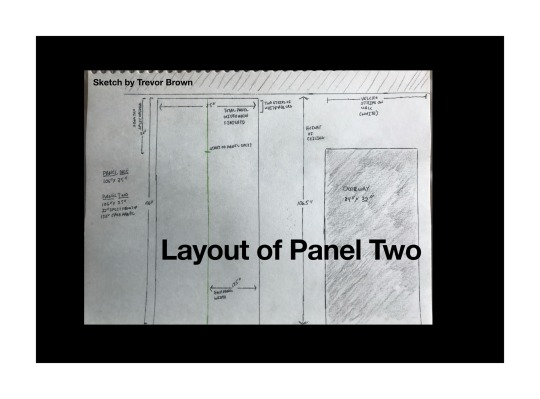
A positive element of my studio space are my very high ceilings, my ceilings are nine feet high which gives the space a lot more openness and light than lower ceilings would. I wanted to emphasize this height and added more clearly defined areas in the apartment.
I recalled a friend of mine Larry Callahan who seemed to move all the time and in each space he inhibited he truly made the space his own, adding elements that were not originally envisioned for the space. Unlike me he has more technical abilities around construction and design being a costume designer. I didn't want my technical capabilities to limit what I wanted, I would simply higher a professional to execute my vision.
If I recall correctly I think my building was built in the twenties which means its about one hundred years old now. Part of the original moldings were in my unit when I first moved in in the late nineties. After the fire some of the elements were removed or replaced to restore the unit to livable conditions. I came to this knowledge not just from my unit, but having been in other units in my building and other units in some of the sister building around me.

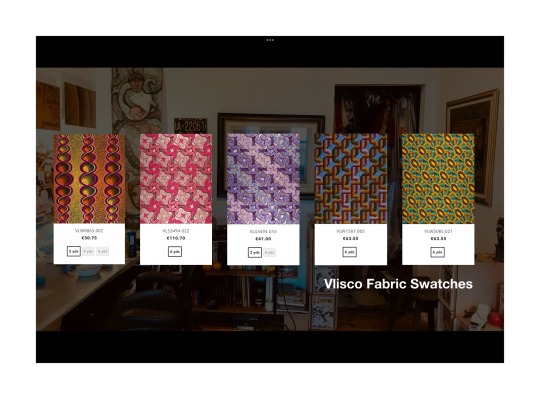
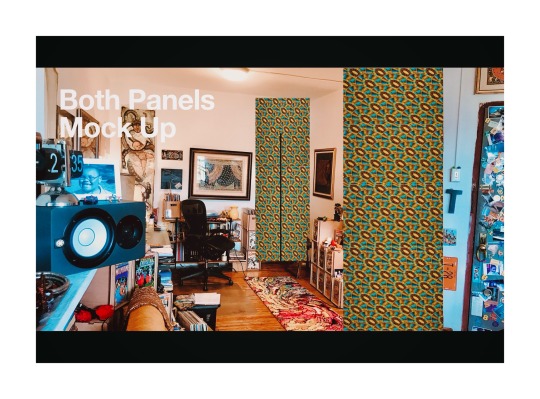
I wanted there to be a break near the front door sort of restoring the original facade that was like a partial proscenium arch or the legs on a stage, the long fabric panels that denote wings in a theatre. I also knew I wanted to use African wax print fabric made by a Dutch company called Vlisco. I knew this wasn't an African company but the quality of their product and designs was frankly superior to some of the in-country designs and I wanted the best for this thousand dollar project. I knew the stiffness of the wax print would lend itself to being a panel. I use the term panel and not curtain because curtains have a tendency to be gathered or bunched up and I wanted a stiff free standing panel of fabric.
To assist in explaining this to Anthony my local tailor who I knew would be a perfect partner for the soft elements I wanted developed for my Ronavations, I put together a deck including screenshots, photos, measurements and reference samples of interiors similar to what I was looking for. But more than that I also worked out the complete construction of the fabric panels, utilizing velcro to adhere them to my walls and being weighted at the bottom to help them stay stiff and erect.
The back panel was primarily being used to mask my walk-in closet with bathroom (the room formerly known as the kitchen) but also give the wall a more finished look. With the lack of doors in my space there aren't clear separations of areas, the panel would let visitors clearly know this was another space and not necessarily one that I wanted folks to wander into sort of the inner sanctum of my apartment.
I was very pleased with the final product once I got over some bumps with Tony fucking up some of the initial panels, which I wanted a large unbroken piece of fabric for some reason he had cut certain piece and then realizing his error put them back together. Meaning I had to order more of this very not-cheap fabric for him to do it right the next time. Of course he ate the cost of that and eventually got it all right.
There are several sets of these panels that I change as my mood desires, I also had cushion covers made in four primary colors that sort of match the base colors of the panels so that I can tie the colors together in the room. The best part of all of this was once again having a vision of something I wanted and realizing that vision.

As an artist I sometimes feel like if it isn't made by my hand its not my creation, and that isn't true. I am sure there are artist who do public sculptures or community murals who are the ones holding the vision for the product and ensuring that it is executed to the parameters that they for saw it. It is the mind behind this creativity that creates the art. And makes me understand why some of my friends feel like my apartment is a museum to my creativity because I have had such a clear hand in designing it in a way that was comfortable and appealing to me.
[Photos by Brown Estate]
#interior design#contractor#tailor#vlisco#renovations#decorative elements#bright colors#textures#artistic process
0 notes
Text
discovered the pattern maker in illustrator and now I'm making my own wax print cloth anwjwjwj
4 notes
·
View notes
Text
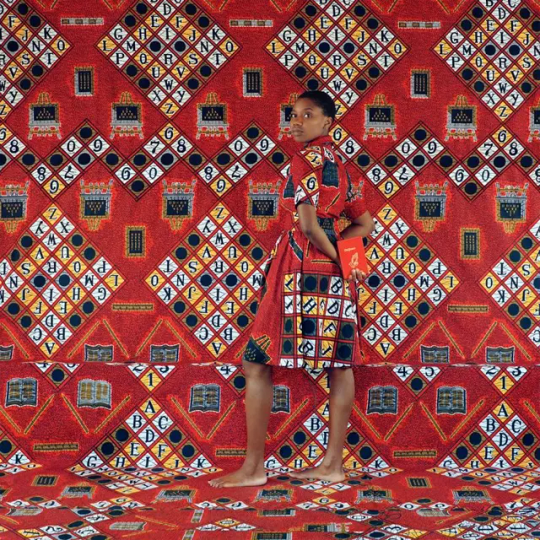
Silvia Rossi, ABC VLISCO 14/0017, 2022
122 notes
·
View notes
Text
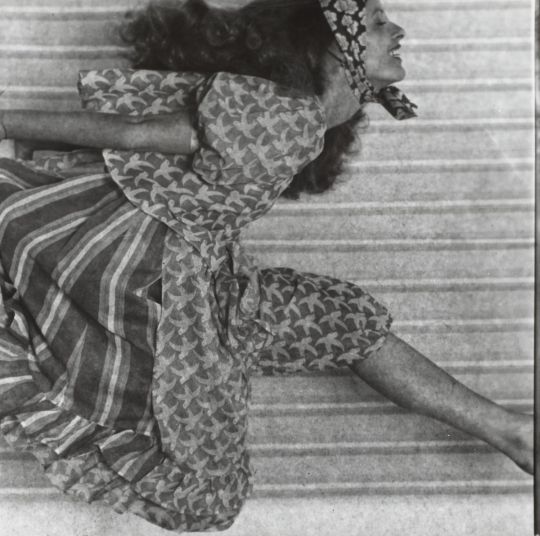
Peter Knapp. Christa Stiegler in Kenzo for Vlisco, 1972.
129 notes
·
View notes
Text
I don’t care- West Africa wins all the prizes: 90% of yall can go home.
There’s a part of me that does not consider West African fashion ~Dandy. Not because it isn’t but because its normal to me. Because I struggle to associate that word with certain members of my own family. People who are pragmatic and practical and never want to rock the boat or stand out…. But sure enough when we go to ethnic functions, They do in fact look Dandy as fuck. It’s the Uniform and Dress code for how we celebrate each other. And seeing the amazing interpretations and representations of that on the carpet tonight put tears in my eyes for real.
Dynasty Ogun+Soull Ogun- L’ Enchanteur^: The lace caplet and maxi-waist beads are such fun fucking details and these two had jewelry all thru the carpet and in the exhibit. (2025 CFDA/Vogue Fashion Fund winners, so fuck yeah here’s hoping for so much more)

Laurie Cumbo +Bobby Digi Olisa
by Adeleke Sijuwade+ Magdy and Kero Maximus* respectively

Ah Yes, Time for my least favorite, yet literally inescapable part of the Met gala!
"Who is that and why are you photographing this ugly ass dress instead?"

Some MilkToast Ass A list motherfucker in the foreground And some folks who probably aren't all that famous in the background Absolutely.Killing it and now I have to look at this ugly shit 10,000 times since I have no way of figuring out who the hell they are other than going through every single one of mya hawks pictures Until I get lucky or there’s an aside picture that names everyone cuz they've gotten all their faces Somehow.
Also, Vlisco's gonna have knock offs in every fucking color back on shelves by the end of this month for SURE.
These two (Lauren and Issa) have the honor (?) of being the only ppl (to my knowledge, natch) who aren't Nigerian or First gen Nigerian American on this list (I don't know for sure about Bobby, but im making a guess)
Issa Rae- Ozwald Boateng

This was the last look that i added to my list, i liked her suit on sight last night, but i didnt see anything too special in it. I was more interested in the person behind her tbqh. Then today I caught a better picture of her at the foot of the steps under all the lights, and oops! I was wrong. The sheen in this wax print is beautiful- I've seen it giving Green, Black and Brown thus far based on the lighting, and I can say from experience that seeing this suit irl is 20x better cuz this kind of wax doesnt ever photograph in a way that does it justice. I almost feel bad for anyone who got too drunk and saw this under any kind of twinkling light cuz i'm sure it made them dizzy
Burna Boy- Ozwald Boateng:

Drop Dead Gorgeous and quintessentially exactly how we do what We DO. And simple with it while having plenty of the personal details that make you feel good to be wearing bespoke. Tailored for the Gods. Look Closer
Tems- Ozwald Boateng:

Gaaatttdamn COME 👏🏿THRU👏🏿 WEST👏🏿 AF👏🏿RI👏🏿CA 👏🏿I got the tiniest peep of the blue behind Issa Rae early in the night and I was like, I"wonder who that could be".... And now, I am FEASTING. Tems is doing an amazing thing that mixes up the kind of bespoke party gowns that west African women wear with suiting. The dress is a suit dress, a vest specifically w. A shirt beneath. The fabric is ankara- 100% cotton used for casual wear or reinforced for suits instead of the usual satin or lace george, tafettas and beaded bedazzled, embroidered netting that you usually see. The Color also just slaps.
I dont know if I have it in me to metrics, but based at least on my rather large list of notable fits, Ozwald Boateng dressed the most people at the party last night, Burberry would be the other contender. And for all that his work is truly pure mens tailoring, its utterly delightful to see how each suit is noticably different in cut and style 😍😍😍
Also! The pattern of the fabric in Tems' bodice and skirt is identical to the one of Issa’s suit!
This (Tems) is woven in wholly matte fabric, while Issa’s is woven in multiple colors and sheens of thread, so in person its kinda shifty- like a more subtle duochrome or like how your white friends eyes change color in different lighting.
Ayo Edebiri- Ferregamo:

African Dandy connected to western formal in gloriously sharp tailoring and accents that scream of looking thru the vlisco fashion catalog and creating something to turn heads with your tailor. Magnificent. There's also more.
Shaboozy- Robbery Wun + Swarovski:

i actively stop being clinically depressed everytime I look at this garment. THOSE BEADS! The shine in the fabric is sublime and the femininity of the silhouette+ the masculinity of the wearer is the kind of gender play that is SORELY lacking in west African culture. For the Met Gala it’s stunning, but for the culture is Actively so damn brave, that it stops me in my tracks. Second place over all in my night, but I wanted to talk about him here with the rest of the fam.
Category winner: John Imah in Sergio Hudson




When I glimpsed somebody in the wings wearing what looked like in a whole ass lavender agbada, with a flash of some kinda red... neck... something? I straight up screamed, and as soon as this man walked into view, I was no longer watching a livestream because I kept rewinding to go back and stare at his 3.5 seconds of screentime. I dont quite have words for the way this look makes me feel, the embroidered detail on the coat itself is STUNNING, and the tailoring is beyond reproach. The cut of the lapel, and in fact that embroidery are reminiscent of an agbada, the white tie of west african (or at least for sure Nigerian) formal menswear, and those coral beads have a few different types of cultural significance, but all of them are connected to ceremony and import. Wedding day, Graduation, coming of age type things.
This is everything the met gala asked for, everything the girlies want to see, and full of such a deep respect for the event and the culture(s) that its speaking to…. Ugh….. I cant, Its simply Every Thing.
#john imah#tems#ayo edebiri#shaboozey#burna boy#issa rae#L’ Enchanteur#Laurie Cumbo#Bobby Digi Olisa#dynasty ogun#soull ogun#Met Gala 2025#met gala 25#fashion#couture#inspo#nigeria#african fashion#naija style#west africa
26 notes
·
View notes


